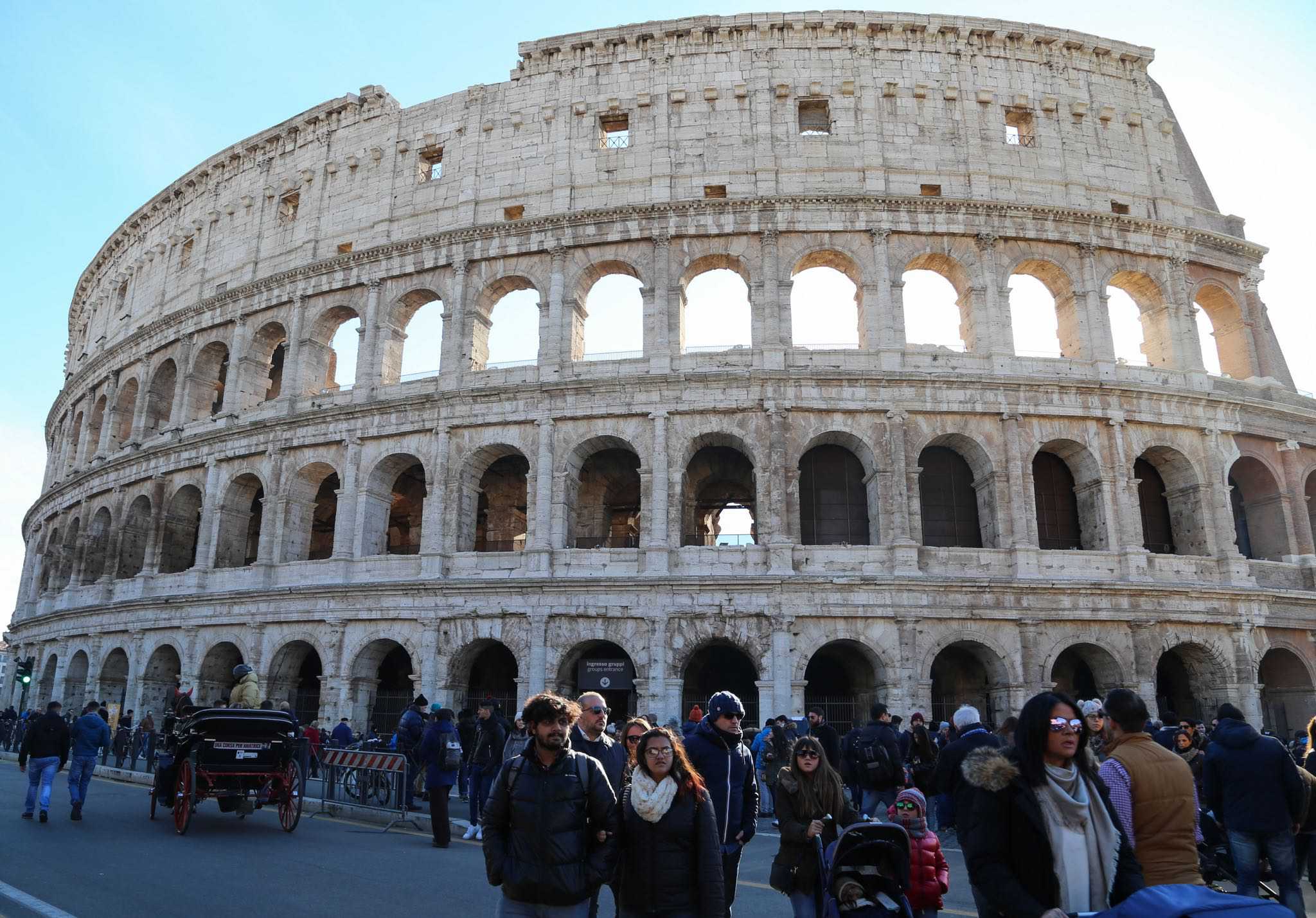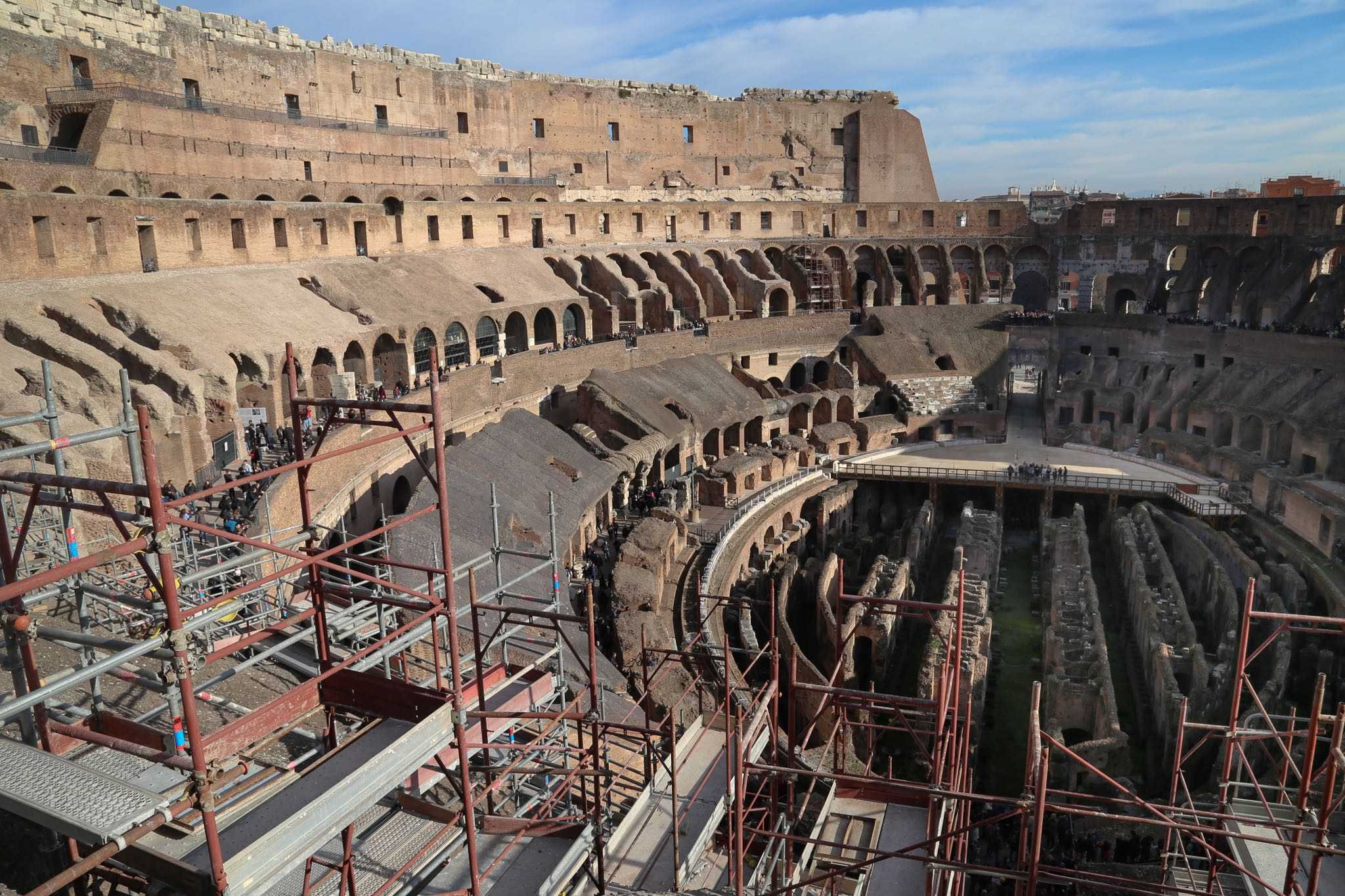
It should come as no surprise that Italy has more UNESCO World Heritage Sites than any other country. The Colosseum was named to the list in 1980, and is undergoing significant restoration. At center-right, the level of the arena floor can be seen.
Architecture is a discipline that sorts order out of complication. It distills design, a disparate collection of elements, a slew of math and engineering, and competing components of volume and space to create an eye-pleasing blend of beauty and function. At its most sublime, architecture can sum up what a culture holds dear and aspires to be. The Colosseum, one of the most iconic architectural wonders of Western civilization, proclaims the greatness of the Roman Empire.

It is a testament to the Colosseum’s unknown architect, the engineers, builders — and slaves — who labored, and still do, to maintain a world treasure.
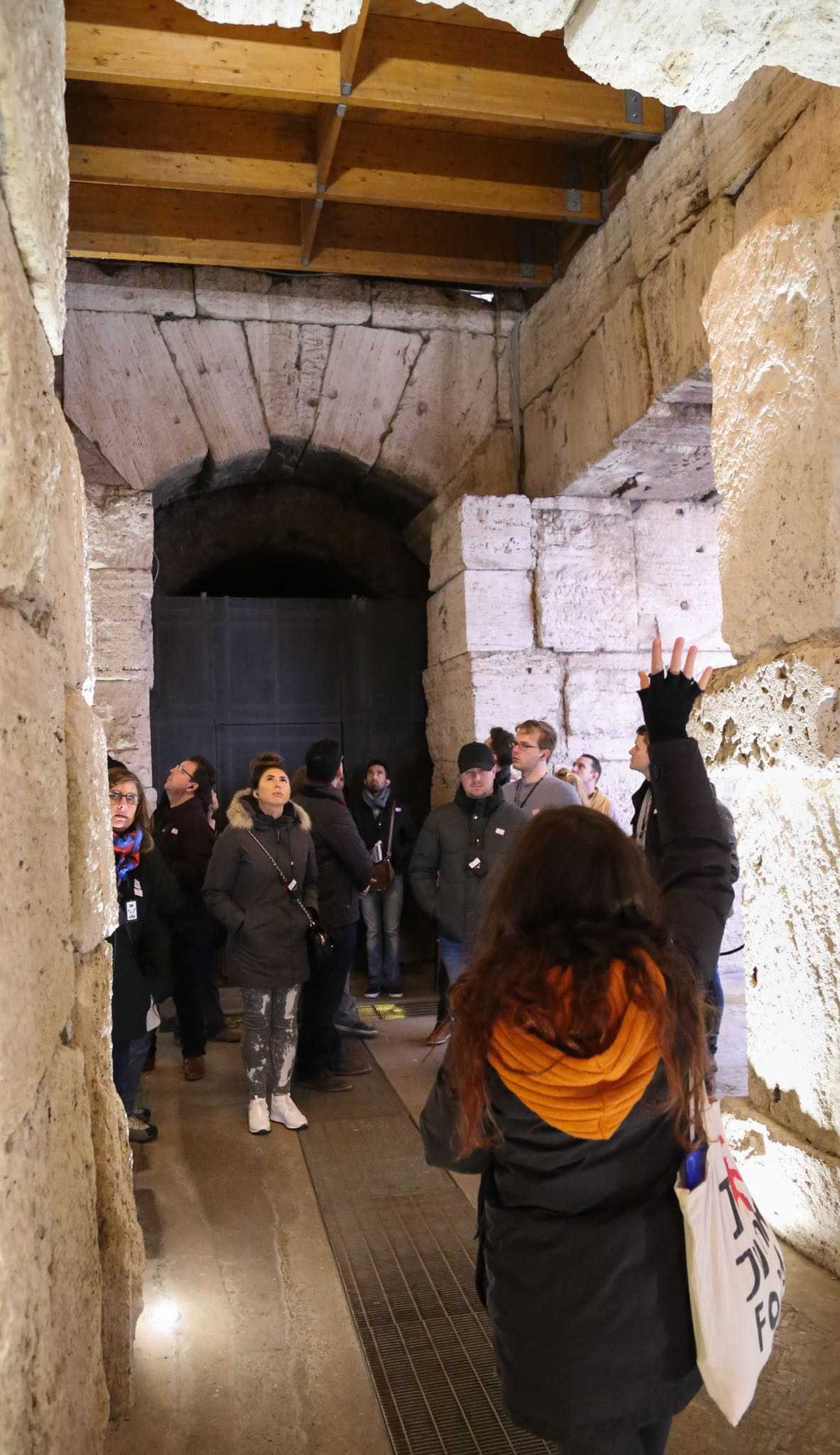
Romans were considered among the world’s best builders, and a significant development can be seen at the top of this photo. The arch is a structural element that is only possible by using a wedge piece, or “keystone” to hold up the arch and distribute the weight out to the sides and down.
A great deal is known about the Colosseum – or Flavian Amphitheater – but one mystery is the name of the architect who designed it. That person has vanished from the pages of history. Like many accomplishments achieved during the Roman Empire, the Colosseum is an idea whose location, and very existence, is a story steeped in intrigue, ambition, and political expediency. Today, the Colosseum is a beloved site, but its beginning arose from a bad ending.
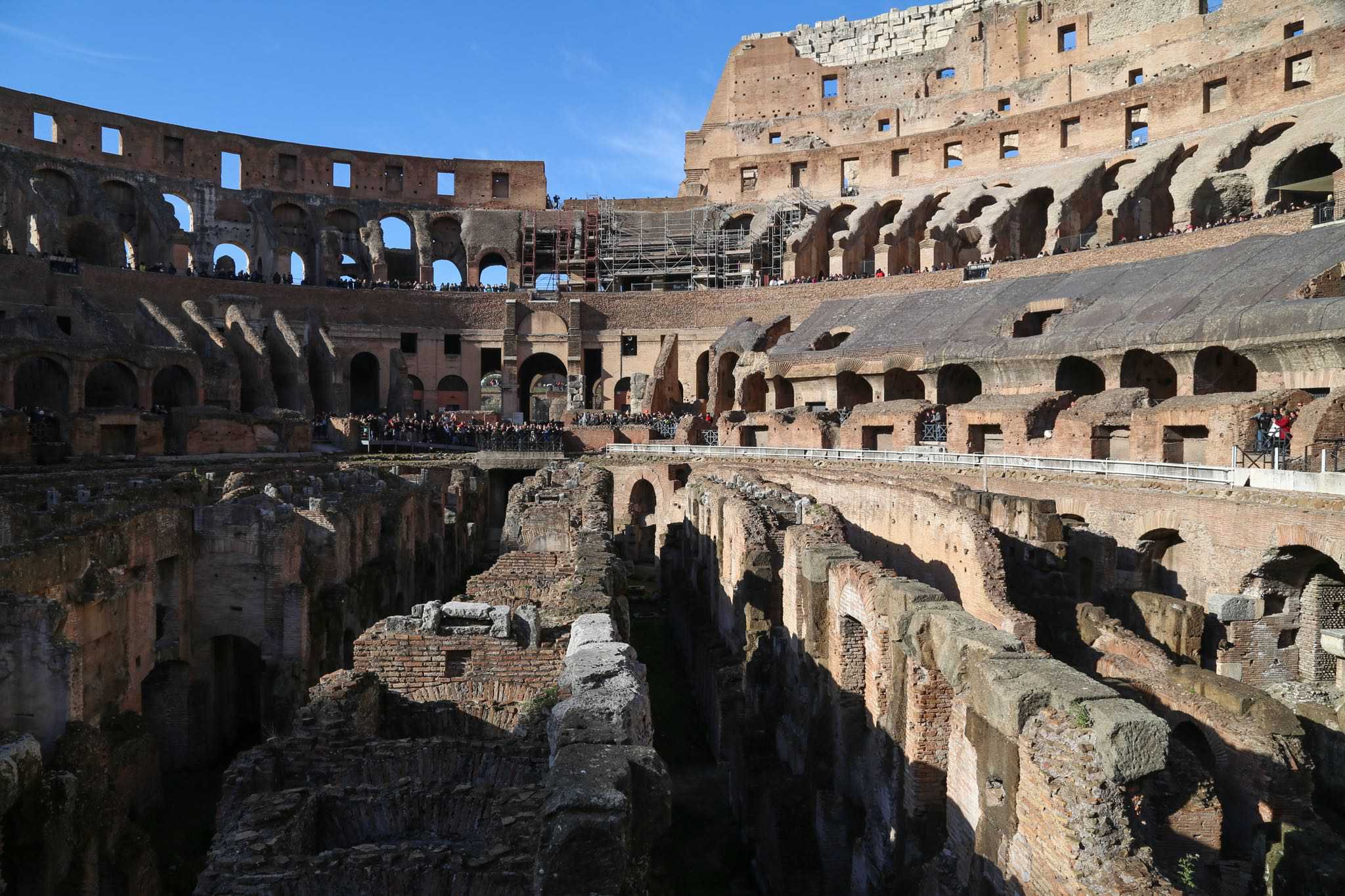
As many as 50,000 spectators would fill the stands — segregated by class — and the entire throng could exit in under 10 minutes.
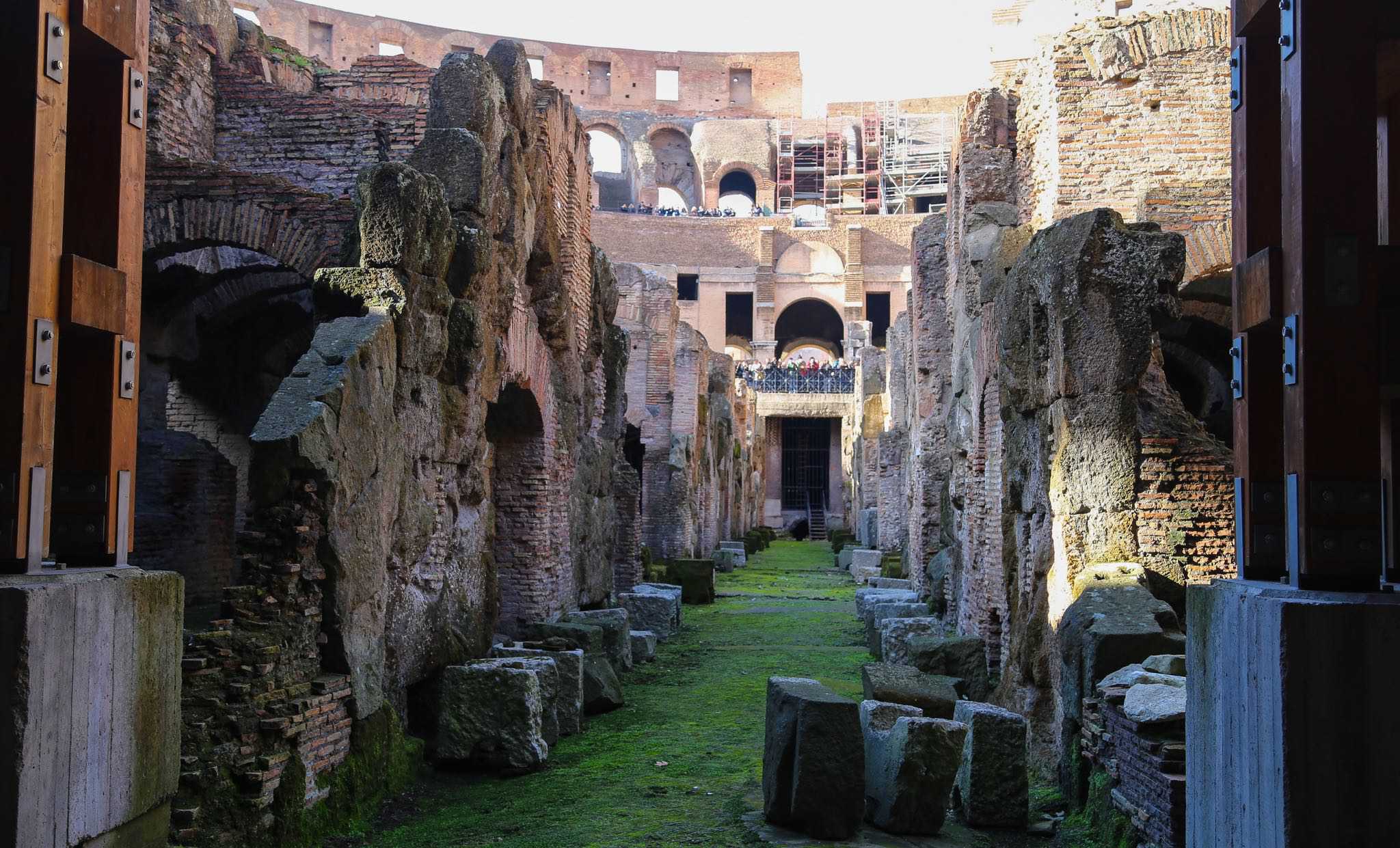
There are a number of brilliant elements in the Colosseum, and the warren of rooms, passageways, and staging areas below the arena floor are design features that transformed events into grand spectacles.
Nero is considered one of the Roman Empire’s most infamous emperors and his historical reputation is as a person who was cruel, may have been mentally imbalanced, had an ego as big as the world, curried favor with the common people by way of rabid populism, and fancied himself as being closer to a god rather than a mere mortal. To achieve and cling to power he lied, connived, had people murdered (including his own mother), and was notorious for rooting out enemies whether they were real or imagined. In many respects, Nero’s was a reign of terror. In 68 A.D. Nero fled Rome and committed suicide after learning he was sentenced to death.

The Colosseum had 80 massive arched entryways so attendees could quickly and easily get to their seats or exit the building.

The Colosseum was much more than a simple arena. In its day it was richly adorned with stylistic touches.
The resulting turmoil following Nero’s death was a time known as “The Year of the Four Emperors.” Nero’s suicide sparked civil war and in quick succession four different men ascended to the role of emperor: Galba, Otho, Vitellius, and Vespasian. The first three were wholly unsuited to the task and ended up dead; Galba was killed by the Praetorain Guard, Otho committed suicide, and Vitellius was killed. Vespasian, on the other hand, ruled with a more even hand, had a better grasp of politics, and won the backing of the common people and elites. Vespasian would be the first of three members of his family to serve in succession as emperor which became known as the Flavian Dynasty, ruling from 69 A.D. to 96 A.D.
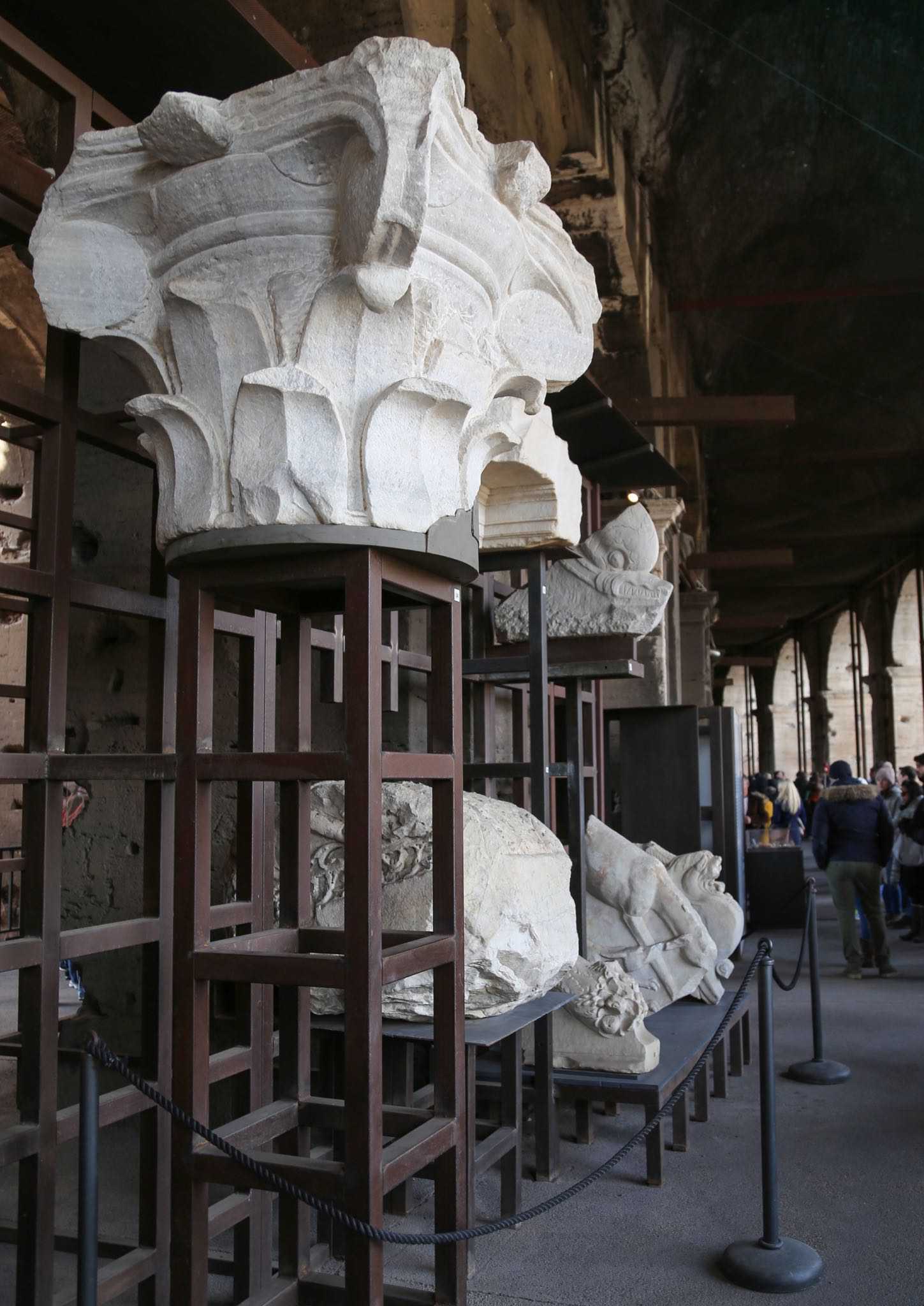
Capitals like the one above, sat atop the many columns of the Colosseum and added beauty and style to a place that oftentimes held events that were ugly and cruel.
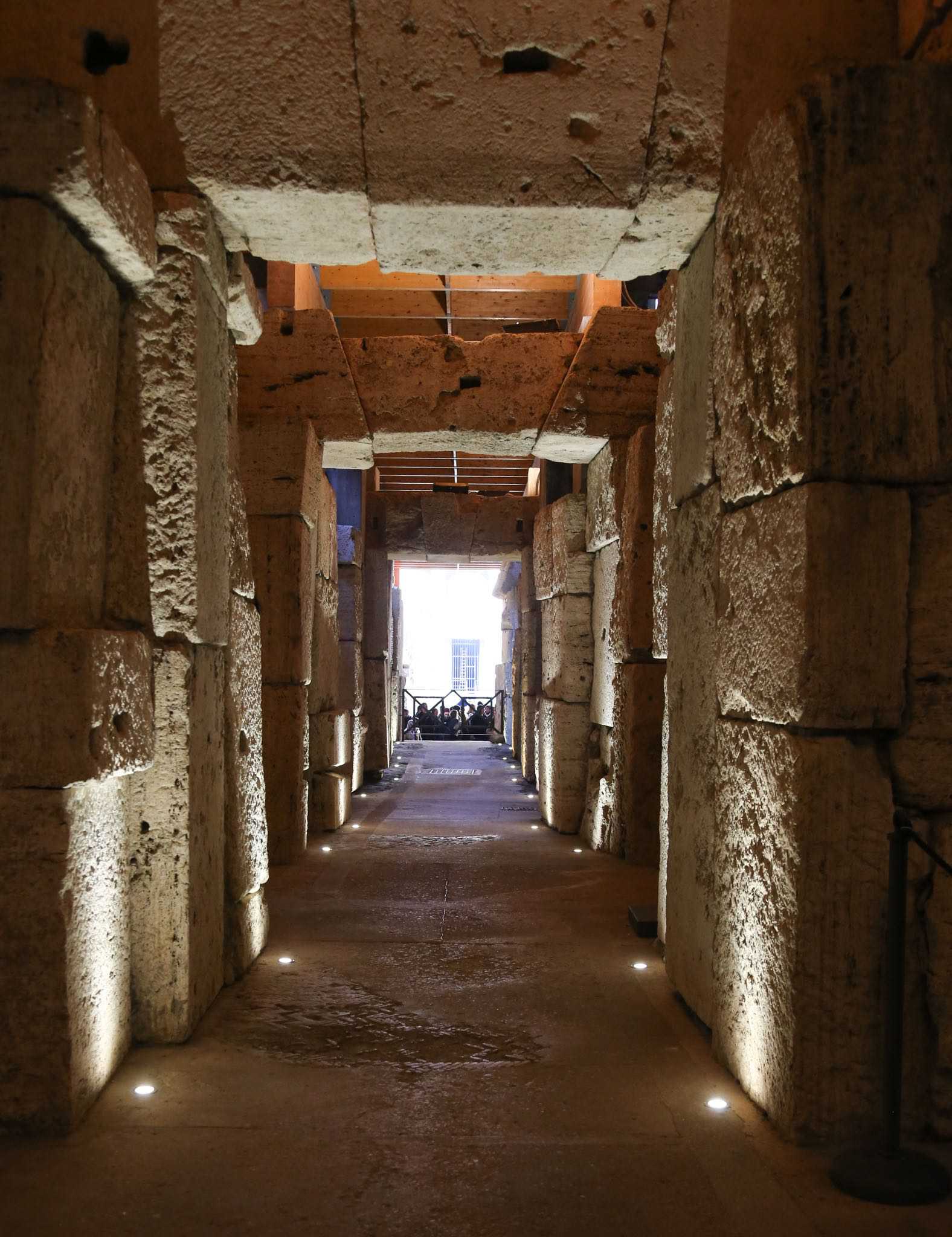
During events, the area underneath the arena floor was a flurry of activity. Depending on the event being held that day, gladiators prepared for battle, wild animals waited to be released, and other theatrical elements were waiting to be sent onstage, to delight the crowds.
Vespasian began work on the Colosseum in 72 A.D., reclaiming a six-acre site that had been appropriated by Nero to be part of his grand palace. The original Colosseum was completed in 80 A.D. under the emperorship of Vespasian’s son Titus, and was further modified by Vespasian’s second son Domitian, from 81 A.D. to 96 A.D. The iconic structure has been standing for nearly two thousand years.
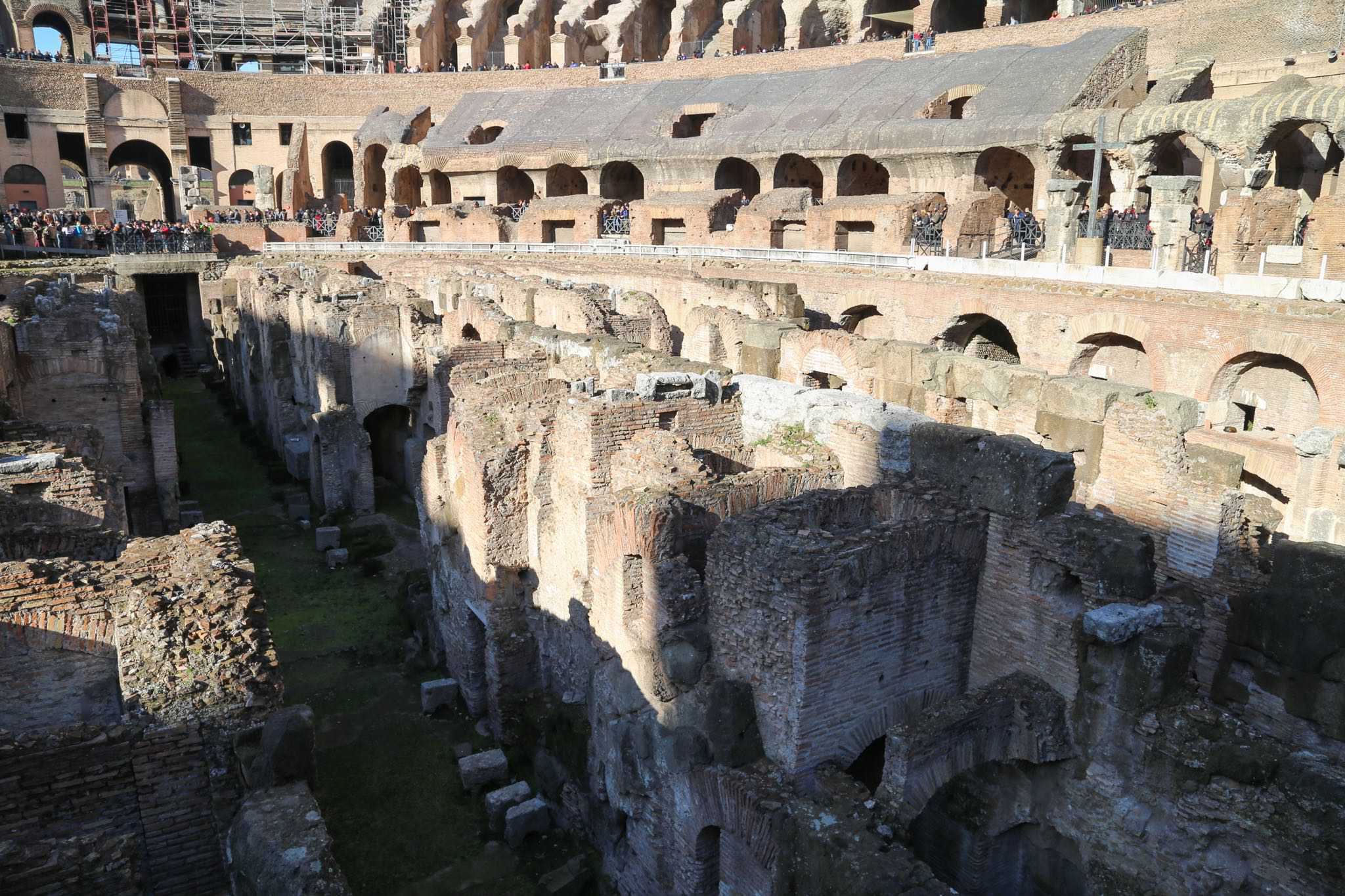
The Hypogeum, the area below the arena floor, was an event producer’s dream. It remains a site of great interest to archeologists, engineers, architects, and builders.
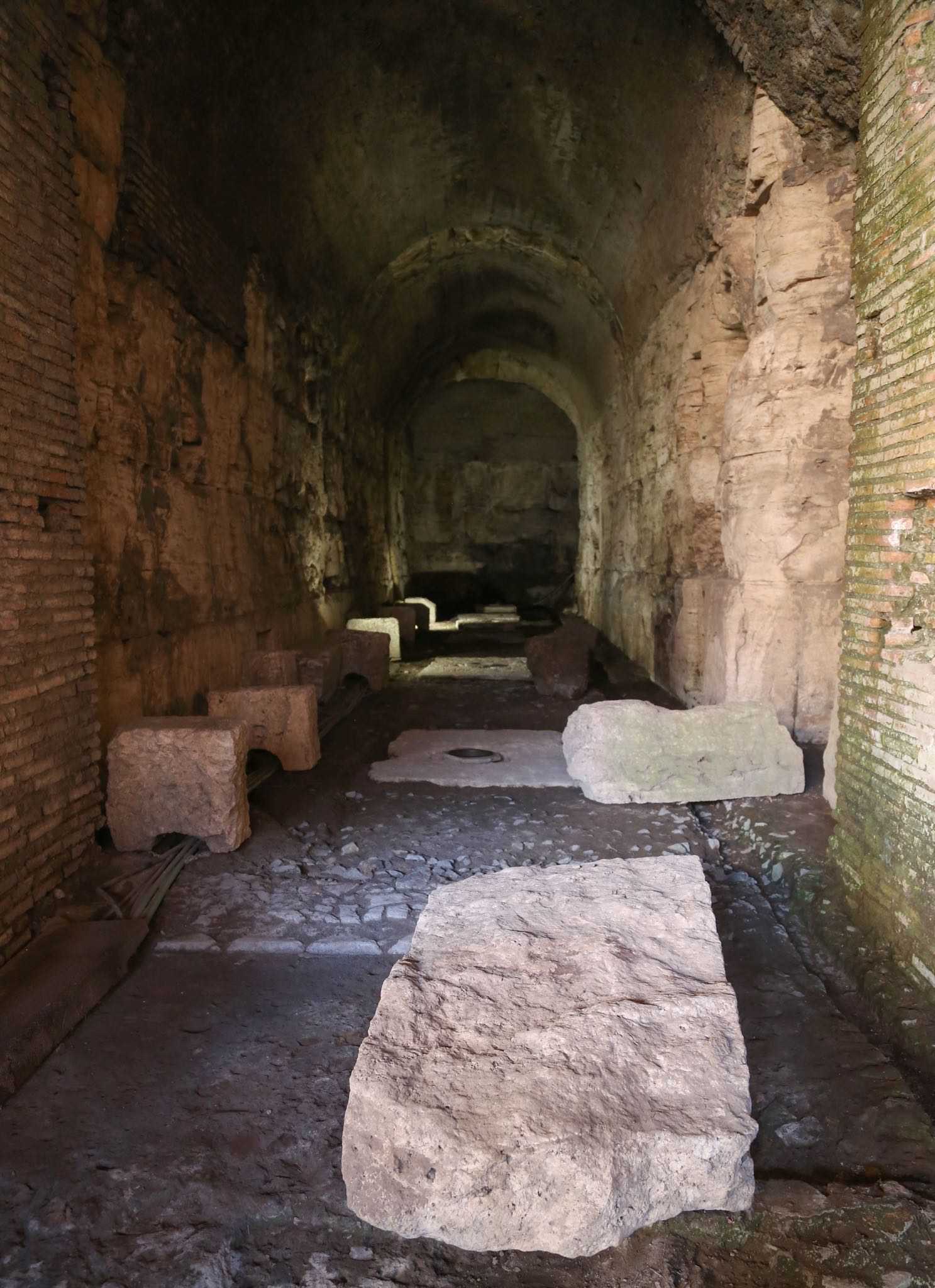
This tunnel, beneath the floor of the Colosseum, served many purposes. Surely, groups of gladiators paused here before rising up to the arena floor where their fates were decided.
The Colosseum could hold more than 50,000 people at a time. The oval-shaped building is 620 feet by 513 feet, and stands 160 feet tall. More than 80 soaring archways let people enter and exit the Colosseum (76 of the archways were used by the masses and the four archways at the ends and center were reserved for the emperor, senators and elites). The design was so efficient the entire amphitheater could easily be emptied in under 10 minutes. Seating was assigned by social and political class. The best seats, for the emperor, were in a prime location near the arena floor. A bit higher up were seats for members of the Roman Senate, and finally standing room areas above the senators for the common people. Admission was generally free, and the highly elaborate, multi-day (even weeks long) events were important political and social occasions. On hot summer days specially-trained crews of sailors operated a velarium system of curtains that acted as a shade awning.
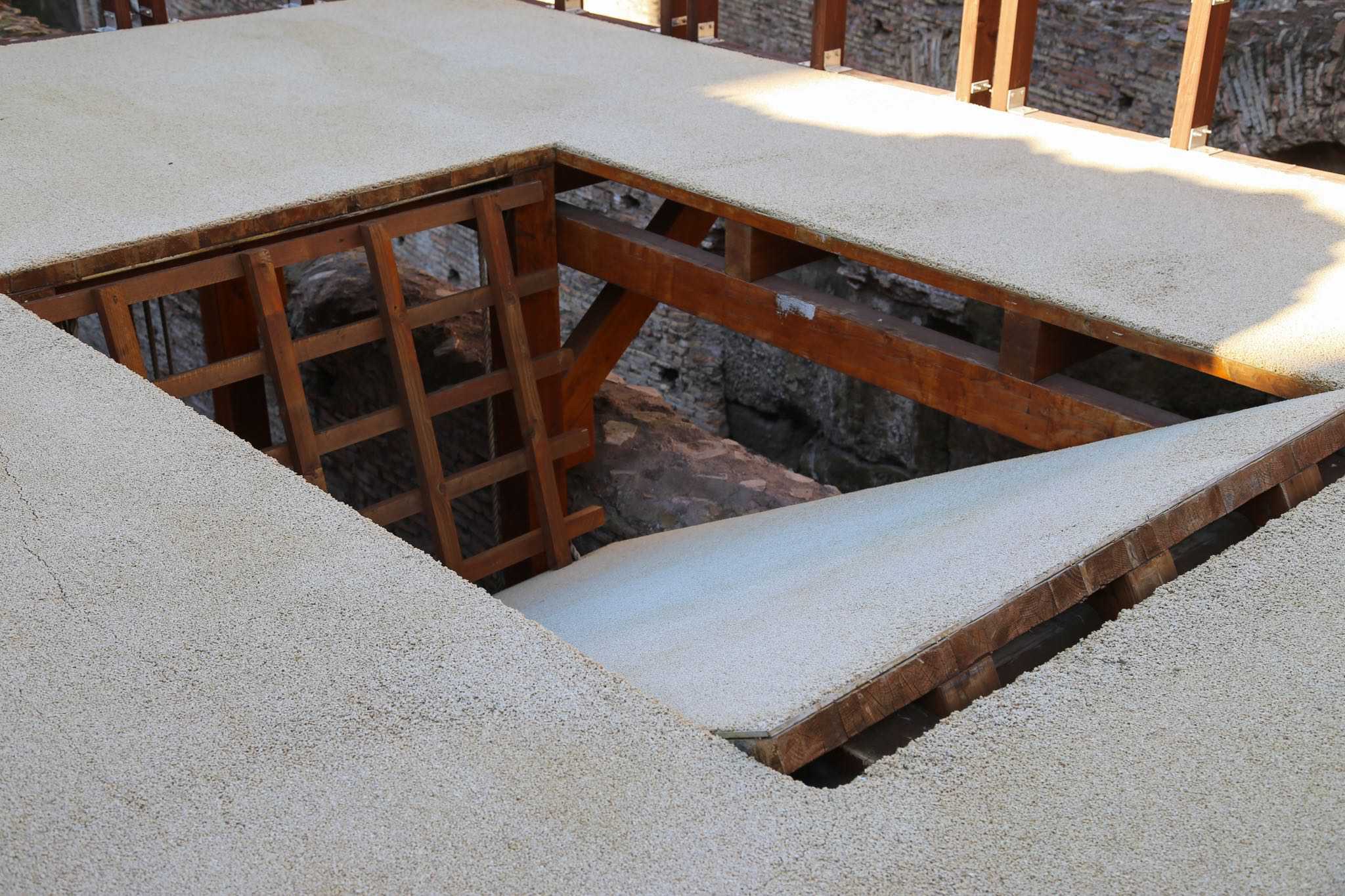
One of the ingenious designs of the Colosseum were trap doors where gladiators, wild animals, chariots, horses, and all manner of things would appear, to the delight of the spectators.
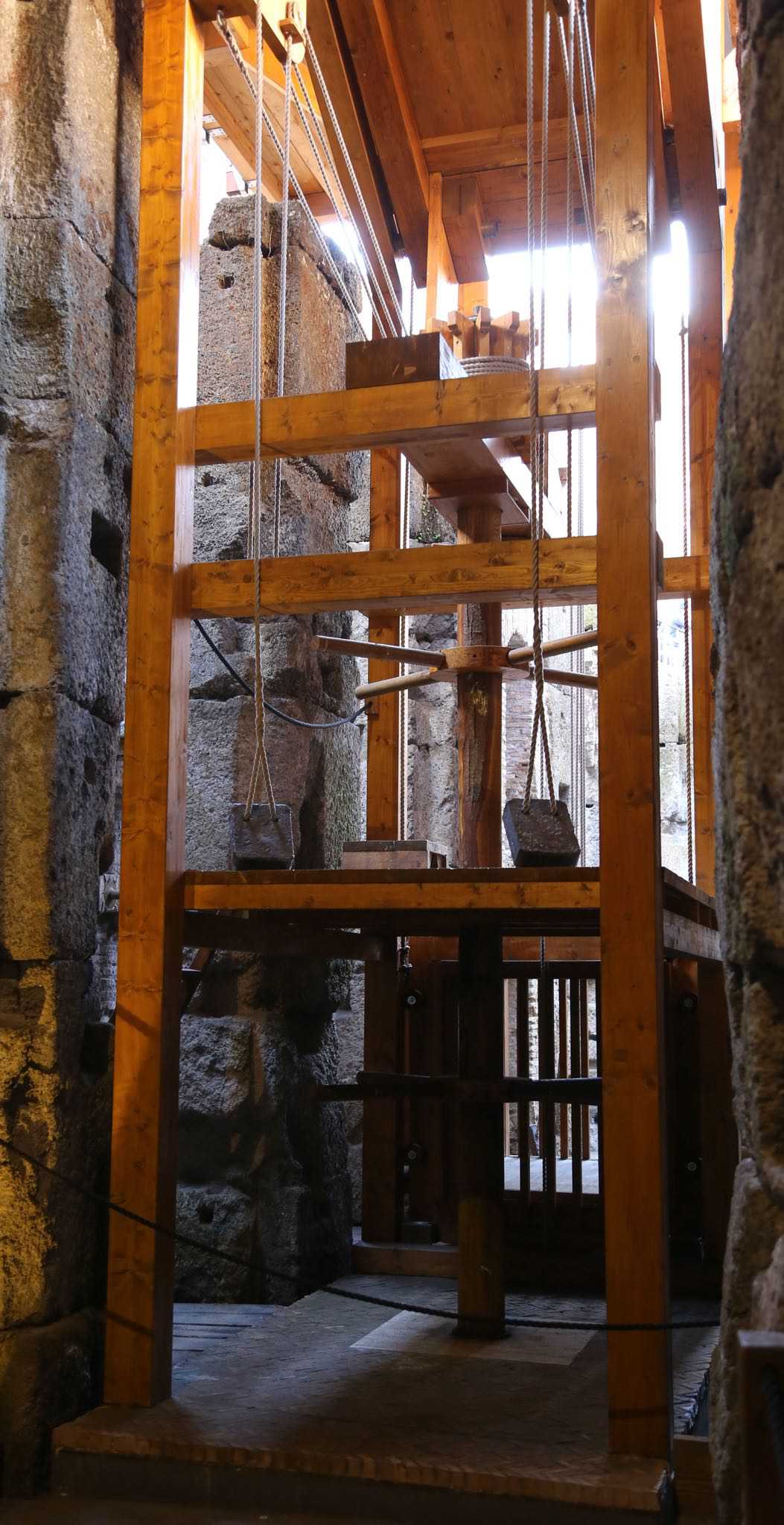
This recreated elevator was powered by workers — usually slaves — who cranked the center post to raise and lower set pieces up to the arena floor, and then back down to the Hypogeum.
Financing for the project was lucre taken from ancient Judea (what is now Israel and a mountainous area of Palestine), after Roman armies put down the Great Jewish Revolt that ended in 73 A.D. Much of the slave labor used to build the amphitheater consisted of Jews captured during fighting in Judea. The work was brutal and many of the slave laborers died during construction. Roman craftsmen and artisans carried out much of the specialty construction and finish work. The project was a massive undertaking of backbreaking effort. Materials used in the building of the Colosseum included tuff, a cemented volcanic ash, travertine limestone quarried from Tivoli, some 20 miles away, marble, bricks for arches, vaults and ribbing, and tiles for decoration. A drainage system utilizing lead and terra cotta pipes was also part of the design.
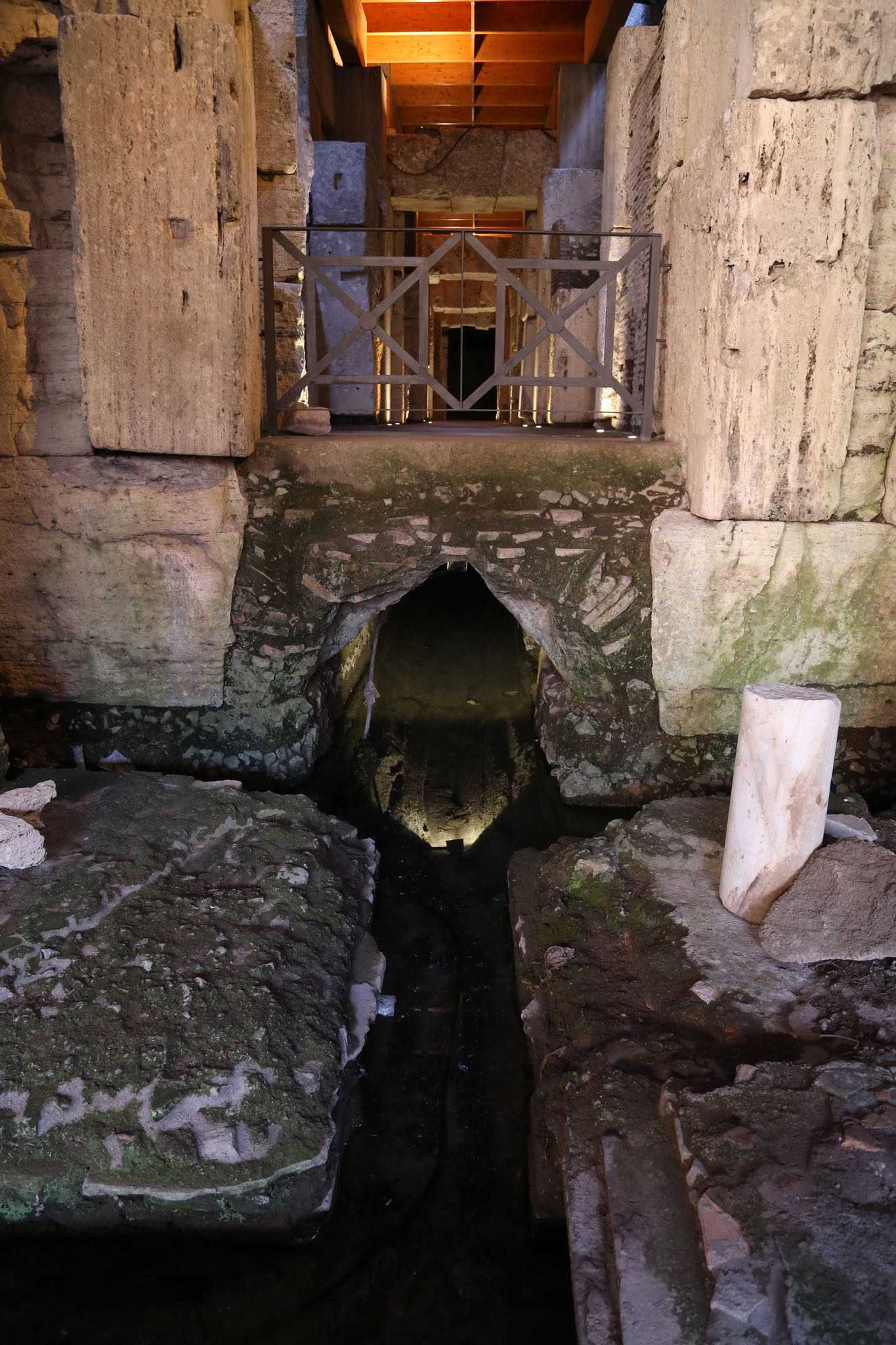
When you have 50,000 spectators along with the blood and gore of battle, there had to be a system to move and dispose of waste and this drainage system served that purpose.
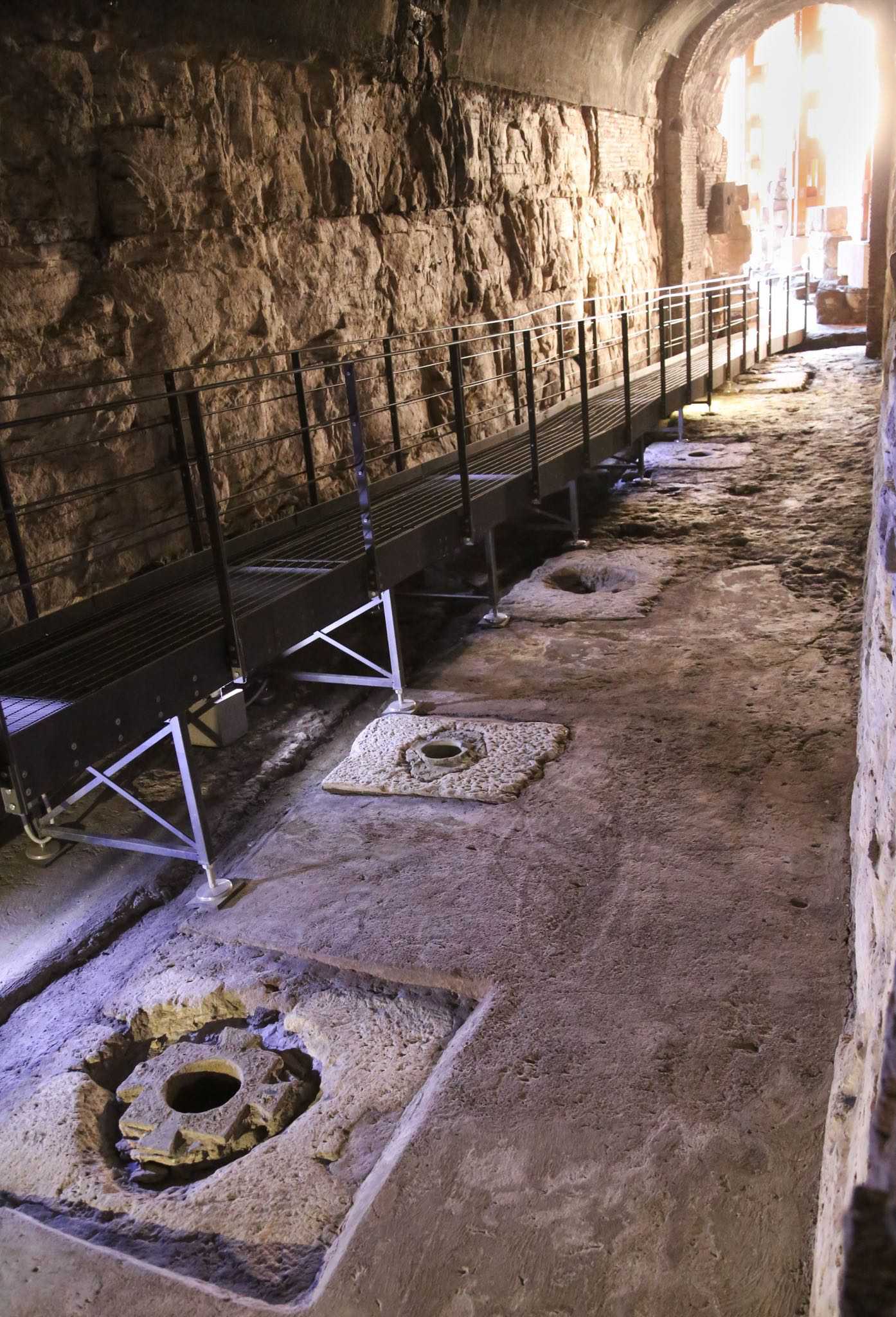
Below the arena floor a series of drains emptied liquids into the sewer system and would be carried away.
All manner of festivities, contests, games, and fights were held at the Colosseum. There were contests between men and animals, and fights between and among gladiators. There is even some evidence there were mock naval battles when the floor of the Colosseum could be flooded and drained. The cost to produce these events was enormous and required 8.000 people – or more – to carry out and produce an event.
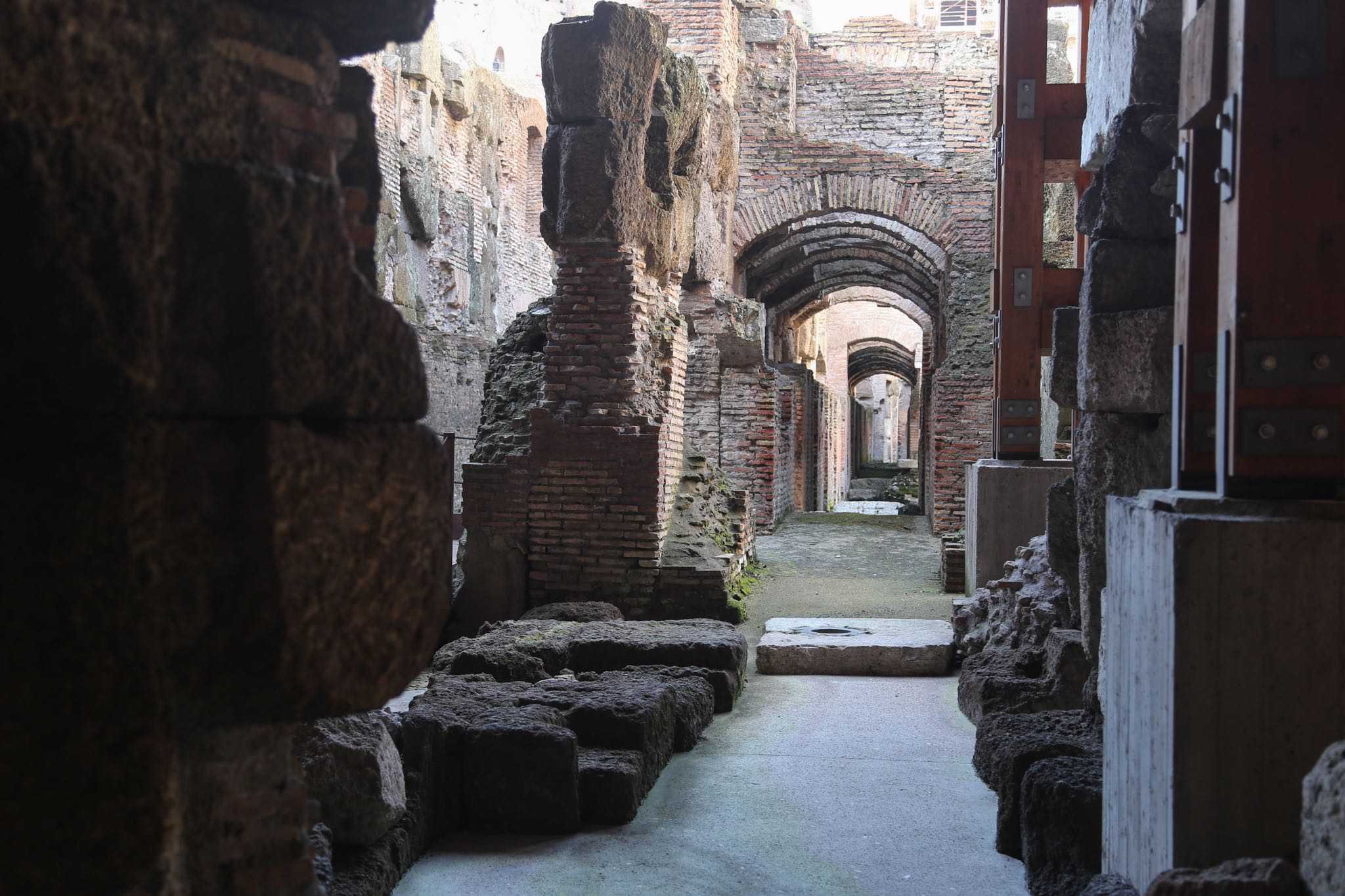
The size, complexity, and brilliant design of the Colosseum is possible thanks to the ability of ancient Romans who developed elements like the arch, which allows for volume and soaring space.

The Arch of Constantine was dedicated in 315 A.D., so it would not have been part of the landscape around the Colosseum until many years later. Built to commemorate Constantine I’s Maxentius victory at the Battle of Milvian Bridge, it is the largest triumphal arch in the Roman Empire.
One of the truly brilliant aspects of the Colosseum was the floor and the basement below. Ringed around the edge of the amphitheater floor were 32 trap doors that would raise men and animals onto the main staging area. Each trap door required upwards of 250 slaves to operate the pulleys, cages, and mechanics of a trap door that released animals or people onto the arena. Bodies and carcasses of the injured or dead could be quickly removed.
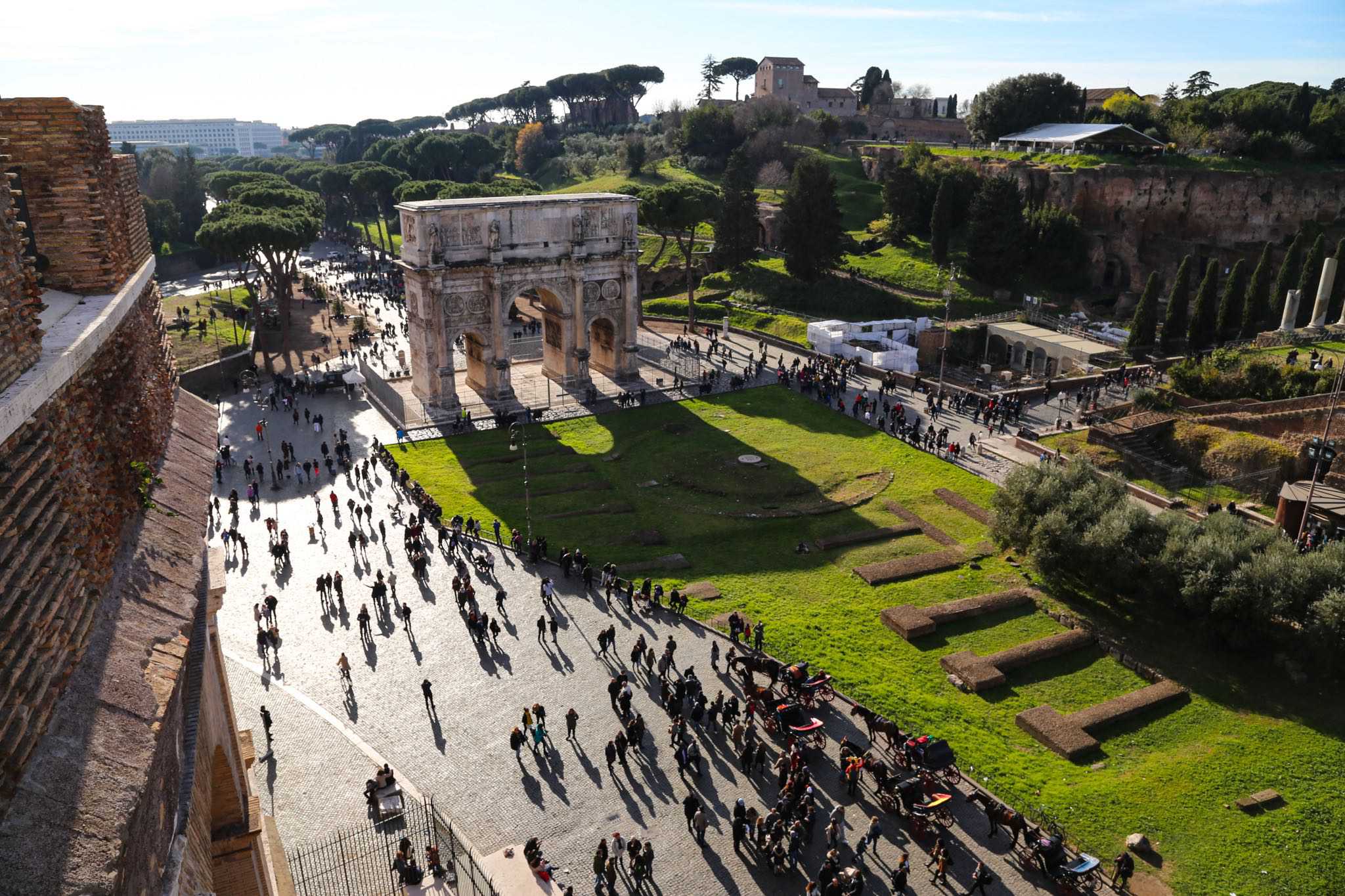
The views from the upper reaches of the Colosseum are indeed sights to behold and it is easy to imagine crowds of ancient Romans wearing tunics and togas, coming and going.
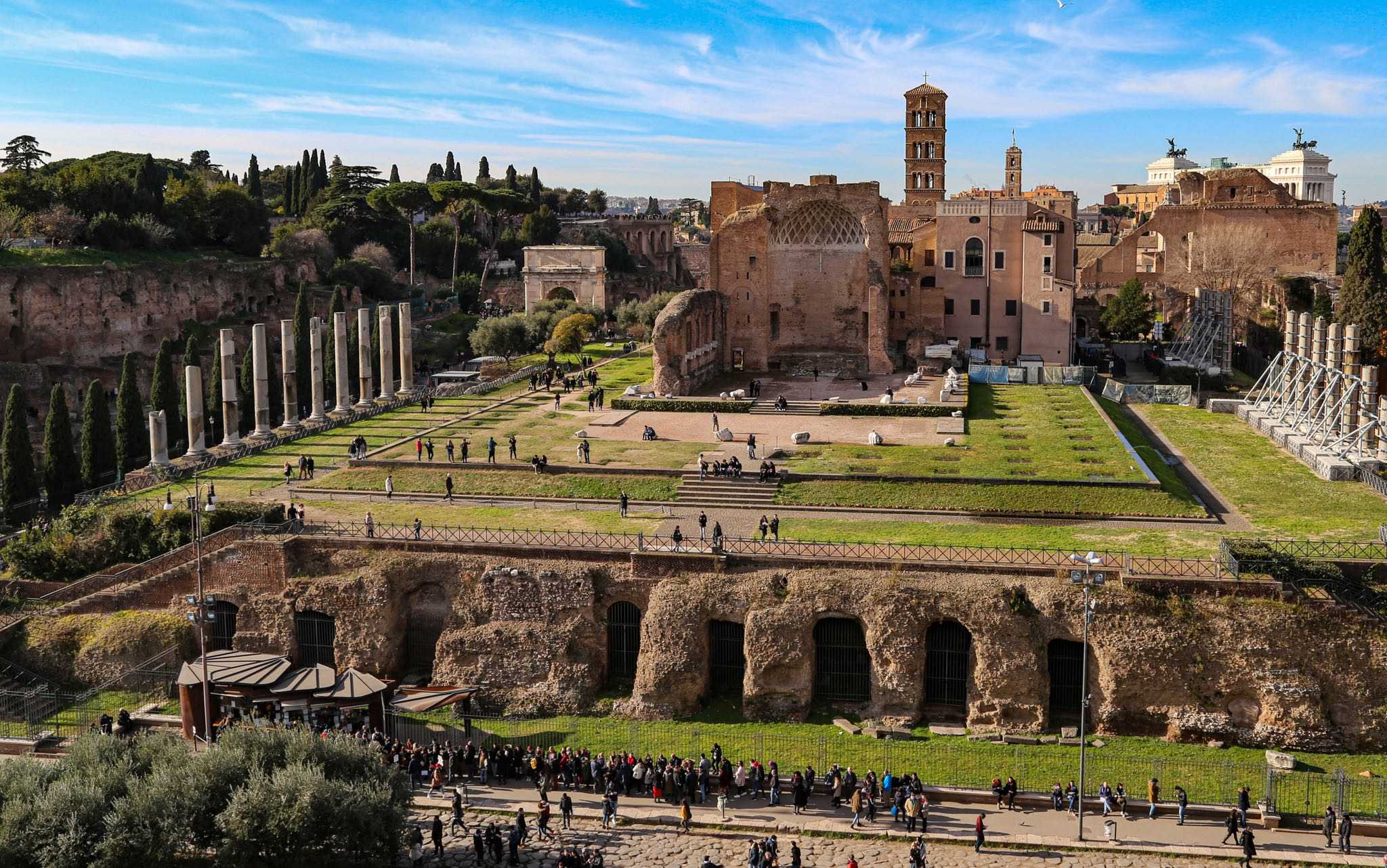
This view, to the west, also from the upper reaches of the Colosseum, offers a glimpse of the magnificence of what remains of Roman architecture. The Temple of Venus and Rome was a design by the Emperor Hadrian, and begun in 121 A.D. The temple was the largest in the Roman Empire.
The floor below the main arena, known as the Hypogeum, is a marvel of engineering and staging. Gladiators, animals, set pieces, engineers, and slaves were able to efficiently produce events for that day. Stage pieces could be raised or lowered, fighters dressed in battle gear appeared, animals slated for killing were released, and the dead and wounded would quickly disappear from view. For those in attendance, it was a grand spectacle. For those standing on the ground floor, it could be life or death. And for those toiling underground, it was loud, grueling toil.
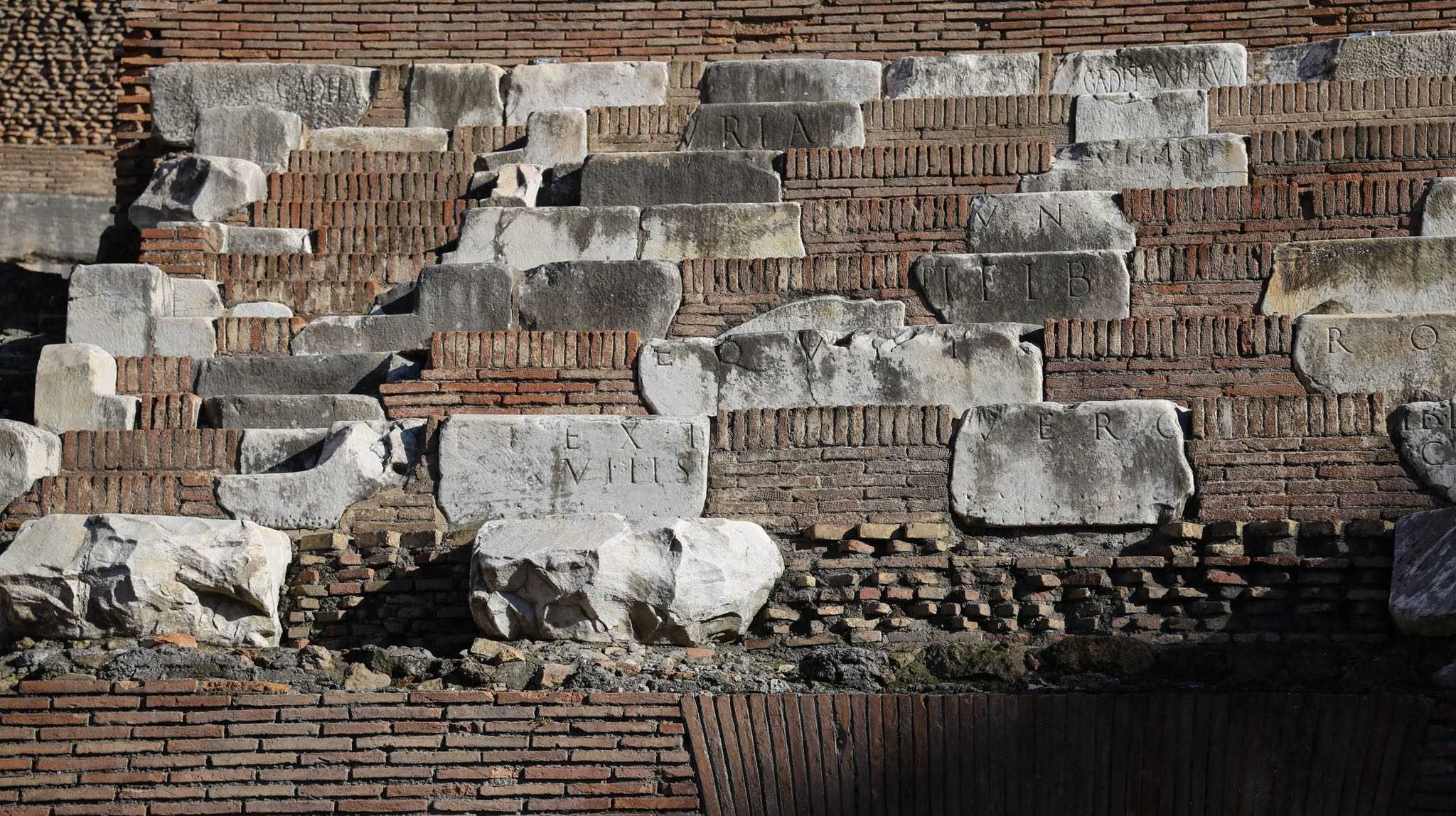
Lower tiers of seats were reserved for senators and elites. Admission to events was generally free of charge.
Today, the Colosseum is one of the top attractions in Rome and the amphitheater receives upwards of four million visitors each year. Tens of millions of dollars are being invested to restore much of the facility to its earlier state. For example, portions of the walls have been rebuilt, seating areas are being renovated, and access points are being restored. Some of the most exciting work being carried out is in the Hypogeum, which suffered a great deal of damage over the centuries. Corridors are being reconfigured to their original designs, trap doors and elevators are being recreated, and rooms and staging areas are seeing new life. Officials are hopeful that the improvements and rehabilitations being done now will enable the Colosseum to last for another two thousand years.
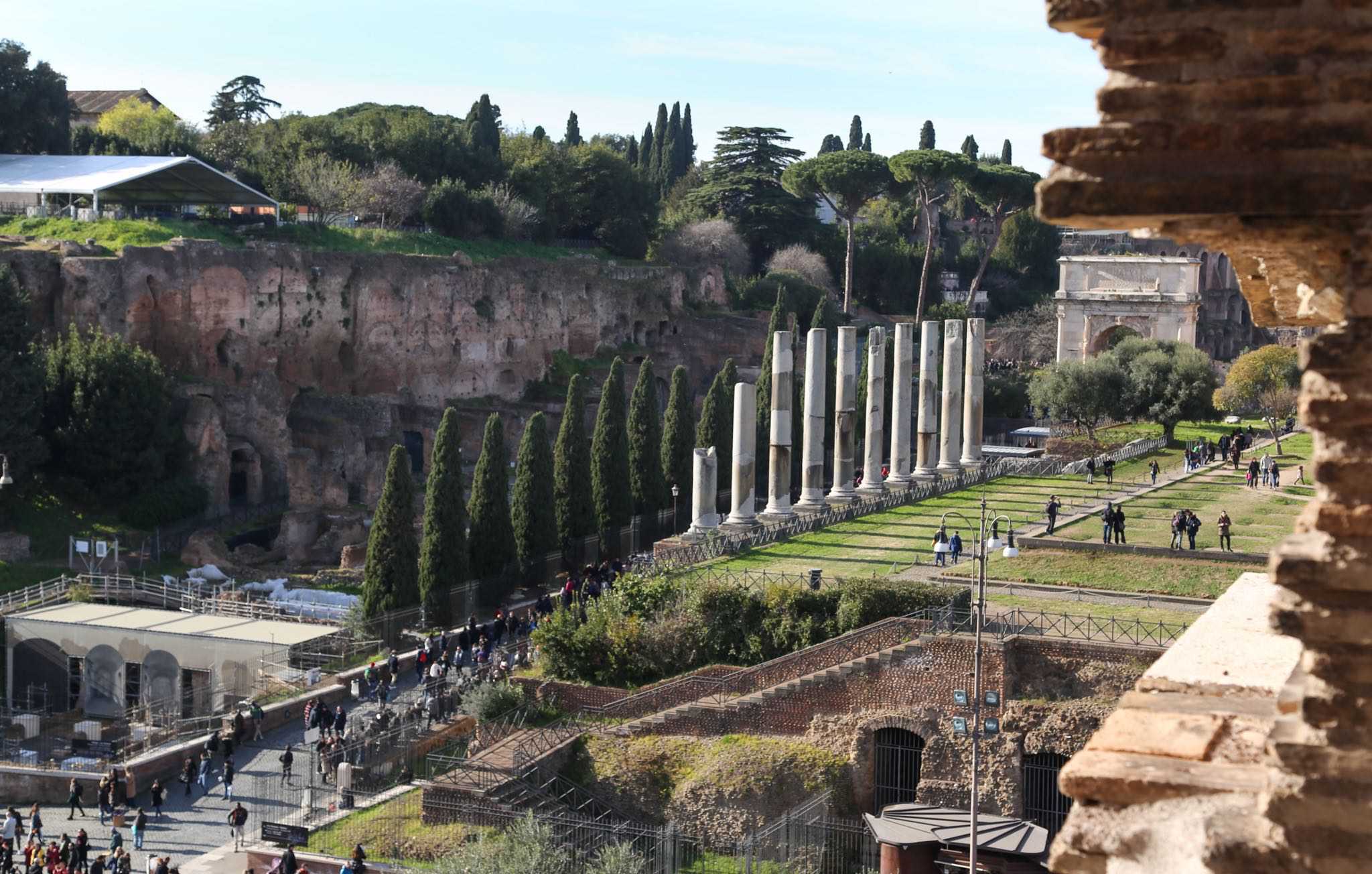
The colonnade that was the site of the Temple of Venus and Rome was constructed by Emperor Hadrian in 121 A.D. and was the largest temple in Rome. The Palatine Hill is behind and above the columns. The Arch of Titus, right, is partially obscured by trees.
The Colosseum was created out of the miseries of Nero’s reign, but due to the vision and efforts of Vespasian, Titus, and Domitian, it was transformed into an engineering and architectural marvel that is one of history’s most iconic and enduring symbols of the great and once-powerful empire known to the world simply as, “Rome.”
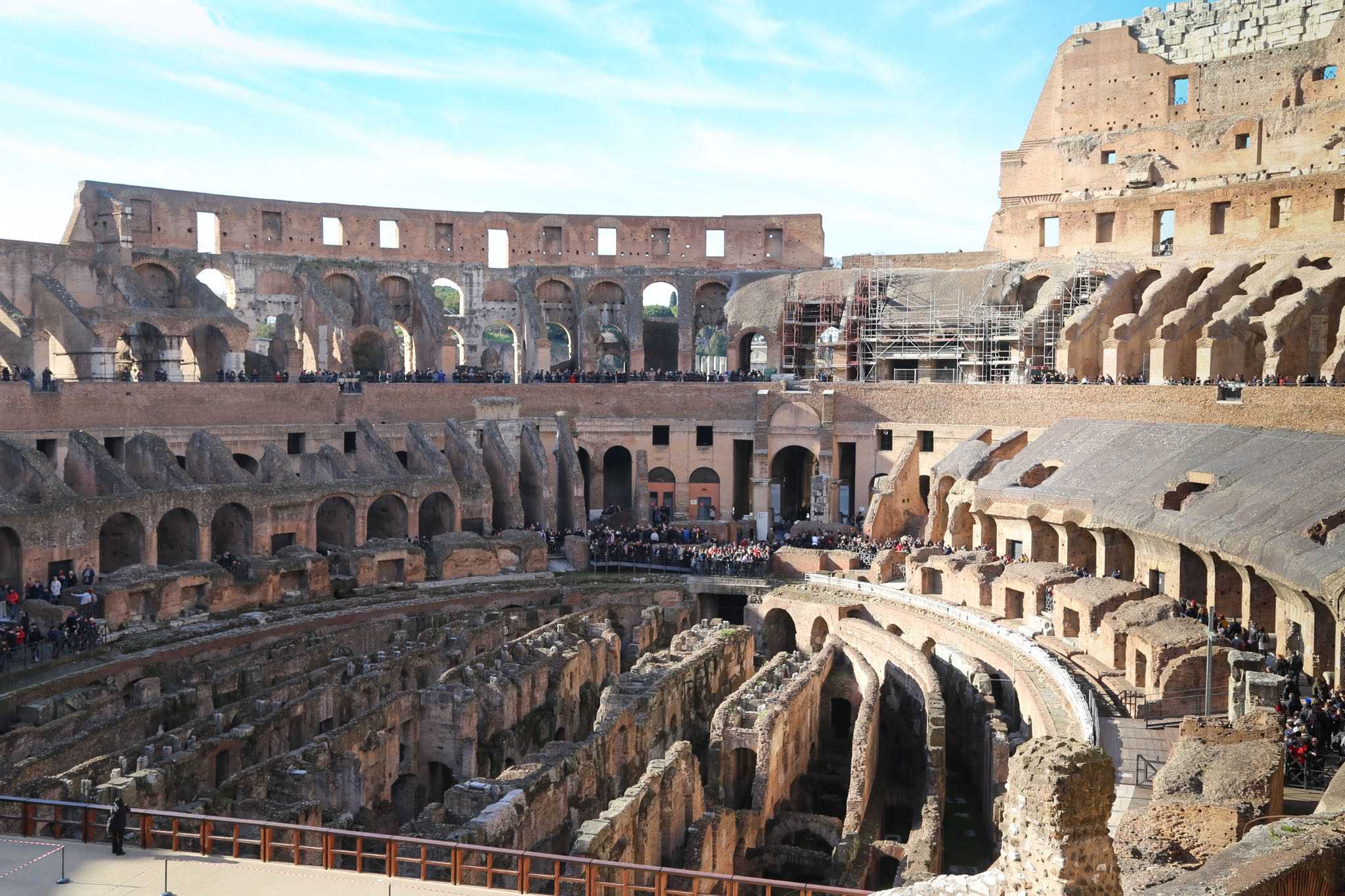
For nearly two thousand years the Colosseum has been drawing spectators and visitors who marvel at the beauty and engineering that symbolized Roman greatness.
For more information about the Colosseum click over to these websites:
https://brewminate.com/engineering-of-the-flavian-ampitheatre-roman-colosseum/
https://wikipedia.org/Colosseum
https://www.history.com/colosseum
https://www.smithsonianmag.com/secrets-of-the-colosseum
https://www.il-colosseo.it/en/colosseo
